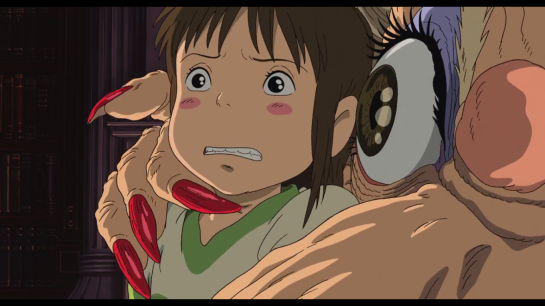Yep, that’s right – we’re doing a Studio Ghibli double feature!

Kiki’s Delivery Service is a lovely film, but Hayao Miyazaki’s later work Spirited Away (2001) is an absolute masterpiece. The film tells the story of Chihiro, a ten-year-old girl whose curious parents accidentally lead her into a magical world. When her parents are transformed into pigs, Chihiro seeks refuge beside a bizarre bathhouse that caters to spirits and monsters: a haven for the strange creatures to replenish their energies. Chihiro makes a friend, Haku, who tells her that she must take a job at the bathhouse to ensure her safety in the spirit world. To receive her work contract, Chihiro must face Yubaba, ruler of the bathhouse: a grand old witch of considerable power.

Hayao Miyazaki has featured witches in quite a few of his films, but Yubaba is by far his most menacing creation. More than anything else, Yubaba is big; her mouth looks wide enough to swallow a child whole, and her bright red fingernails are as long and sharp as daggers. Her work at the bathhouse has also made her rich. Enormous jewelled rings glitter beside her knuckles, and her penthouse apartment is filled with gold and precious stones.
Is Yubaba wicked? Yes, she is – but it’s truer to say that she’s just a very shrewd businesswoman. She takes Chihiro’s name from her as payment (rechristening her as Sen) and sets her to work washing floors and scrubbing tubs, hoping that the girl might forget her name and remain a servant forever.

I know this is a post about witches, but it should also be said that the other spirits and monsters in Spirited Away are an absolute pleasure to behold. The most memorable is probably No-Face, a mute phantom who lures victims in with promises of gold and trinkets, but all of the creatures are dazzling in their own right. There’s Kamaji, the spider-limbed man who works in the boiler room; the River Spirit, a heavily polluted nature being with the head of a golden skull; and even Chihiro’s friend Haku, who can take the form of a coiling sky dragon. Yubaba also has three monstrous henchmen of her own: a giant baby (apparently her son), a trio of bouncing green heads, and a jet black raven with Yubaba’s own face. The film radiates with inventive visuals; every single frame is a work of art.

Yubaba ends up getting distracted by No-Face’s ravenous rampage, and so Chihiro is able to free Haku from his servitude and force the witch to allow her to bargain for her freedom. Yubaba then reveals her final test: to return home with her parents, Chihiro must inspect a line of pigs and correctly choose which of the swine are her mother and father. It’s a wonderful little puzzle, but the wise and brave Chihiro solves it almost at once, leaving Yubaba fuming. Chihiro thanks Yubaba for everything, and then leaves the spirit world once and for all.
And so ends one of the best and most beautiful films ever made.
Final Musings
— Really, no other filmmaker gets me empathising like Miyazaki. When Chihiro faces a challenging situation, I genuinely fear for her; when she displays kindness, she genuinely moves me. Spirited Away gets me bad, but the empathy hits me even worse in My Neighbour Totoro; the character Mei reduces me to a blubbering wreck almost as soon as the film starts.
— But I do really love Chihiro. She starts the film with less courage than Mei or Kiki, but she still faces obstacles with the same compassion and determination found in all of Miyazaki’s young heroines. I’d love to see all three characters share a scene together!
— The Japanese spirit world of Spirited Away shares quite a few similarities with the worlds of European fairy tales. In both cases, food is shown to be of high importance: in traditional fairy lore, eating fairy food will entrap a human in the fairy realm forever, and in Spirited Away, eating the feast outside the bathhouse is what turns Chihiro’s parents into pigs. A human character having to remember their true name is another theme common to both sets of stories.
— I’ve glossed over a lot of plot strands in my summary above, but it’s worth mentioning that Yubaba has a twin sister who is also a witch. The twin’s name is Zeniba, and she gives Chihiro a special hair tie when Chihiro returns the witch’s magical golden seal. This is a very normal scene by Miyazaki’s standards.
— Another unexplored aspect of Yubaba’s backstory is her casual remark that she never should have taken that oath to “give a job to anyone who asks.” Why did she do that?
— Now that I think about it, the two antagonists of Spirited Away really are consistently fascinating characters. Throughout the story, both No-Face and Yubaba seem to help Chihiro just as much as they hinder her, and she ends the film on good terms with both. Like most Studio Ghibli films, Spirited Away defies narrative conventions!
— Spirited Away has the best spirits and monsters of any Miyazaki film, but there are also some very good creatures in My Neighbour Totoro (1988), Princess Mononoke (1997), Howl’s Moving Castle (2004), and Ponyo (2008). Ponyo was the first Miyazaki film I ever saw, and it completely hooked me on his unique brand of storytelling and visual creativity. If you don’t know where to start, you might as well start there!
— Ponyo and Howl’s Moving Castle also have witch characters in them, but I think we’ve delved into enough Studio Ghibli films for now. Next time, we’ll be looking at an Australian witch – which I think is the only Australian witch I’ve ever managed to find. Come back soon and read all about it!
Happy witching!


One thought on “Witch No. 13: Yubaba”